Flame-Retarded Rigid Polyurethane Foam Composites with the Incorporation of Steel Slag/Dimelamine Pyrophosphate System: A New Strategy for Utilizing Metallurgical Solid Waste
Abstract
1. Introduction
2. Results and Discussion
2.1. Bubble Structure of RPUF and RPUF-R Composites
2.2. Physical Properties of RPUF and RPUF-R Composites
2.3. Flame Retardant Properties of RPUF and RPUF-R Composites
2.4. Thermal Stability of RPUF and RPUF-R Composites
2.5. Combustion Properties of RPUF and RPUF-R Composites
2.6. Analysis of Gas Phase Products of RPUF and RPUF-R Composites
2.7. Carbon Slag Analysis of RPUF and RPUF-R Composites
3. Experiment
3.1. Experimental Materials
3.2. Sample Foaming
3.3. Sample Characterization
4. Conclusions
Author Contributions
Funding
Institutional Review Board Statement
Informed Consent Statement
Data Availability Statement
Acknowledgments
Conflicts of Interest
References
- Huang, Y.B.; Jiang, S.H.; Liang, R.C.; Sun, P.; Hai, Y.; Zhang, L. Thermal-triggered insulating fireproof layers: A novel fire-extinguishing MXene composites coating. Chem. Eng. J. 2020, 391, 123621. [Google Scholar] [CrossRef]
- Dong, M.Y.; Li, Q.; Liu, H.; Liu, C.T.; Wujcik, E.K.; Shao, Q.; Ding, T.; Mai, X.M.; Shen, C.Y.; Guo, Z.H. Thermoplastic polyurethane-carbon black nanocomposite coating: Fabrication and solid particle erosion resistance. Polymer 2018, 158, 381–390. [Google Scholar] [CrossRef]
- Tang, G.; Zhou, L.; Zhang, P.; Hang, Z.Q.; Chen, D.P.; Liu, X.Y.; Zhou, Z.J. Effect of aluminum diethylphosphinate on flame retardant and thermal properties of rigid polyurethane foam composites. J. Therm. Anal. Calorim. 2020, 140, 625–636. [Google Scholar] [CrossRef]
- Tan, C.J.; Lee, J.J.L.; Ang, B.C.; Andriyana, A.; Chagnon, G.; Sukiman, M.S. Design of polyurethane fibers: Relation between the spinning technique and the resulting fiber topology. J. Appl. Polym. Sci. 2019, 136, 47706. [Google Scholar] [CrossRef]
- Tang, G.; Liu, M.R.; Deng, D.; Zhao, R.Q.; Liu, X.L.; Yang, Y.D.; Yang, S.J.; Liu, X.Y. Phosphorus-containing soybean oil-derived polyols for flame-retardant and smoke-suppressant rigid polyurethane foams. Polym. Degrad. Stab. 2021, 191, 109701. [Google Scholar] [CrossRef]
- Naldzhiev, D.; Mumovic, D.; Strlic, M. Polyurethane insulation and household products-a systematic review of their impact on indoor environmental quality. Build. Environ. 2020, 169, 106559. [Google Scholar] [CrossRef]
- Yuan, Y.; Wang, W.; Shi, Y.Q.; Song, L.; Ma, C.; Hu, Y. The influence of highly dispersed Cu2O-anchored MoS2 hybrids on reducing smoke toxicity and fire hazards for rigid polyurethane foam. J. Hazard. Mater. 2020, 382, 121028. [Google Scholar] [CrossRef]
- Gajdzik, B. Polish crude steel production in pandemic year of 2020 compared to previous five years. Metalurgija 2022, 61, 137–140. [Google Scholar]
- Yüksel, İ. A review of steel slag usage in construction industry for sustainable development. Environ. Dev. Sustain. 2016, 19, 369–384. [Google Scholar] [CrossRef]
- Yi, H.; Xu, G.; Cheng, H.; Wang, J.; Wan, Y.; Chen, H. An overview of utilization of steel slag. Procedia Environ. Sci. 2012, 16, 791–801. [Google Scholar] [CrossRef]
- Gencel, O.; Karadag, O.; Oren, O.H.; Bilir, T. Steel slag and its applications in cement and concrete technology: A review. Constr. Build. Mater. 2021, 283, 122783. [Google Scholar] [CrossRef]
- Guo, J.; Bao, Y.; Wang, M. Steel slag in China: Treatment, recycling, and management. Waste Manag. 2018, 78, 318–330. [Google Scholar] [CrossRef] [PubMed]
- Wang, Z.Y.; Li, J.F.; He, X.L.; Yang, G.; Qi, J.Y.; Zhao, C. Organic pollutants removal performance and enhanced mechanism investigation of surface-modified steel slag particle electrode. Environ. Prog. Sustain. Energy 2019, 38, S7–S14. [Google Scholar] [CrossRef]
- Thomas, C.; Rosales, J.; Polanco, J.A.; Agrela, F. New Trends in Eco-Efficient and Recycled Concrete; Woodhead Publishing: Sawston, UK, 2019; pp. 169–190. [Google Scholar]
- Xu, J.Y.; Li, K.D.; Deng, H.M.; Lv, S.; Fang, P.K.; Liu, H.; Shao, Q.; Guo, Z.H. Preparation of MCA-SiO2 and its flame retardant effects on glass fiber reinforced polypropylene. Fibers Polym. 2019, 20, 120–128. [Google Scholar] [CrossRef]
- Tang, G.; Liu, X.L.; Yang, Y.D.; Chen, D.P.; Zhang, H.; Zhou, L.; Zhang, P.; Deng, D. Phosphorus-containing silane modified steel slag waste to reduce fire hazards of rigid polyurethane foams. Adv. Powder Technol. 2020, 31, 1420–1430. [Google Scholar] [CrossRef]
- Levchik, S.V.; Balabanovich, A.I.; Levchik, G.F.; Costa, L. Effect of melamine and its salts on combustion and thermal decomposition of polyamide 6. Fire Mater. 1997, 21, 75–83. [Google Scholar] [CrossRef]
- Sut, A.; Metzsch-Zilligen, E.; Großhauser, M.; Pfaendner, R.; Schartel, B. Synergy between melamine cyanurate, melamine polyphosphate and aluminum diethylphosphinate in flame retarded thermoplastic polyurethane. Polym. Test. 2019, 74, 196–204. [Google Scholar] [CrossRef]
- Xu, M.; Ma, Y.; Hou, M.; Bourbigot, S. Synthesis of a cross-linked triazine phosphine polymer and its effect on fire retardancy, thermal degradation and moisture resistance of epoxy resins. Polym. Degrad. Stab. 2015, 119, 14–22. [Google Scholar] [CrossRef]
- Lai, X.; Tang, S.; Li, H.; Zeng, X. Flame-retardant mechanism of a novel polymeric intumescent flame retardant containing caged bicyclic phosphate for polypropylene. Polym. Degrad. Stab. 2015, 113, 22–31. [Google Scholar] [CrossRef]
- Liu, L.; Xu, Y.; Xu, M.; Li, Z.; Hu, Y.; Li, B. Economical and facile synthesis of a highly efficient flame retardant for simultaneous improvement of fire retardancy, smoke suppression and moisture resistance of epoxy resins. Compos. Part B-Eng. 2019, 167, 422–433. [Google Scholar] [CrossRef]
- Liu, L.B.; Xu, Y.; Xu, M.J.; He, Y.T.; Li, S.; Li, B. An efficient synergistic system for simultaneously enhancing the fire retardancy, moisture resistance and electrical insulation performance of unsaturated polyester resins. Mater. Des. 2020, 187, 108302. [Google Scholar] [CrossRef]
- Akdogan, E.; Erdem, M.; Ureyen, M.E.; Kaya, M. Rigid polyurethane foams with halogen-free flame retardants: Thermal insulation, mechanical, and flame retardant properties. J. Appl. Polym. Sci. 2020, 137, 47611. [Google Scholar] [CrossRef]
- Chai, H.; Duan, Q.; Jiang, L.; Sun, J. Effect of inorganic additive flame retardant on fire hazard of polyurethane exterior insulation material. J. Therm. Anal. Calorim. 2018, 135, 2857–2868. [Google Scholar] [CrossRef]
- Almessiere, M.A.; Slimani, Y.; Güngüneş, H.; Korkmaz, A.D.; Zubar, T.; Trukhanov, S.; Trukhanov, A.; Manikandan, A.; Alahmari, F.; Baykal, A. Influence of Dy3+ ions on the microstructures and magnetic, electrical, and microwave properties of [Ni0.4Cu0.2Zn0.4](Fe2-xDyx)O4 (0.00 ≤ x ≤ 0.04) spinel ferrites. ACS Omega 2021, 6, 10266–10280. [Google Scholar] [CrossRef] [PubMed]
- Darwish, M.A.; Zubar, T.I.; Kanafyev, O.D.; Zhou, D.; Trukhanova, E.L.; Trukhanov, S.V.; Trukhanov, A.V.; Henaish, A.M. Combined effect of microstructure, surface energy, and adhesion force on the friction of PVA/ferrite spinel nanocomposites. Nanomaterials 2022, 12, 1998. [Google Scholar] [CrossRef] [PubMed]
- Chen, K.X.; Yang, D.; Shi, Y.Q.; Feng, Y.Z.; Fu, L.B.; Liu, C.; Chen, M.; Yang, F.Q. Synergistic function of N-P-Cu containing supermolecular assembly networks in intumescent flame retardant thermoplastic polyurethane. Polym. Adv. Technol. 2021, 32, 4450–4463. [Google Scholar] [CrossRef]
- Yang, S.; Zhang, B.; Liu, M.; Yang, Y.; Liu, X.; Chen, D.; Wang, B.; Tang, G.; Liu, X. Fire performance of piperazine phytate modified rigid polyurethane foam composites. Polym. Adv. Technol. 2021, 32, 4531–4546. [Google Scholar] [CrossRef]
- Yang, R.; Wang, B.; Xu, L.; Zhao, C.X.; Zhang, X.; Li, J.C. Synthesis and characterization of rigid polyurethane foam with dimer fatty acid-based polyols. Polym. Bull. 2019, 76, 3753–3768. [Google Scholar] [CrossRef]
- Pang, X.; Xin, Y.; Shi, X.Z.; Xu, J.Z. Effect of different size--modified expandable graphite and ammonium polyphosphate on the flame retardancy, thermal stability, physical, and mechanical properties of rigid polyurethane foam. Polym. Eng. Sci. 2019, 59, 1381–1394. [Google Scholar] [CrossRef]
- Tang, G.; Liu, X.L.; Zhou, L.; Zhang, P.; Deng, D.; Jiang, H.H. Steel slag waste combined with melamine pyrophosphate as a flame retardant for rigid polyurethane foams. Adv. Powder Technol. 2020, 31, 279–286. [Google Scholar] [CrossRef]
- Kaya, H.; özdemir, E.; Kaynak, C.; Hacaloglu, J. Effects of nanoparticles on thermal degradation of polylactide/aluminium diethylphosphinate composites. J. Anal. Appl. Pyrolysis 2016, 118, 115–122. [Google Scholar] [CrossRef]
- Chambhare, S.U.; Lokhande, G.P.; Jagtap, R.N. Design and UV-curable behaviour of boron based reactive diluent for epoxy acrylate oligomer used for flame retardant wood coating. Des. Monomers Polym. 2016, 20, 125–135. [Google Scholar] [CrossRef] [PubMed]
- Liu, L.B.; Xu, Y.; He, Y.T.; Xu, M.J.; Shi, Z.X.; Hu, H.C.; Yang, Z.C.; Li, B. An effective mono-component intumescent flame retardant for the enhancement of water resistance and fire safety of thermoplastic polyurethane composites. Polym. Degrad. Stab. 2019, 167, 146–156. [Google Scholar] [CrossRef]
- Wang, X.; Song, L.; Pornwannchai, W.; Hu, Y.; Kandola, B. The effect of graphene presence in flame retarded epoxy resin matrix on the mechanical and flammability properties of glass fiber-reinforced composites. Compos. Part A Appl. Sci. Manuf. 2013, 53, 88–96. [Google Scholar] [CrossRef]
- Zhang, J.H.; Kong, Q.H.; Yang, L.W.; Wang, D.Y. Few layered Co(OH)2 ultrathin nanosheet-based polyurethane nanocomposites with reduced fire hazard: From eco-friendly flame retardance to sustainable recycling. Green Chem. 2016, 18, 3066–3074. [Google Scholar] [CrossRef]
- Chattopadhyay, D.K.; Webster, D.C. Thermal stability and flame retardancy of polyurethanes. Prog. Polym. Sci. 2009, 34, 1068–1133. [Google Scholar] [CrossRef]
- Chen, M.J.; Chen, C.R.; Tan, Y.; Huang, J.Q.; Wang, X.L.; Chen, L.; Wang, Y.Z. Inherently flame-retardant flexible polyurethane foam with low content of phosphorus-containing cross-linking agent. Ind. Eng. Chem. Res. 2014, 53, 1160–1171. [Google Scholar] [CrossRef]
- Liu, C.; Zhang, P.; Shi, Y.; Rao, X.; Cai, S.; Fu, L.; Feng, Y.; Wang, L.; Zheng, X.; Yang, W. Enhanced fire safety of rigid polyurethane foam via synergistic effect of phosphorus/nitrogen compounds and expandable graphite. Molecules 2020, 25, 4741. [Google Scholar] [CrossRef]
- Yang, S.; Mo, L.; Deng, M. Effects of ethylenediamine tetra-acetic acid (EDTA) on the accelerated carbonation and properties of artificial steel slag aggregates. Cem. Concr. Compos. 2021, 118, 103948. [Google Scholar] [CrossRef]
- Chen, X.L.; Ma, C.Y.; Jiao, C.M. Synergistic effects between iron-graphene and melamine salt of pentaerythritol phosphate on flame retardant thermoplastic polyurethane. Polym. Adv. Technol. 2016, 27, 1508–1516. [Google Scholar] [CrossRef]
- Chen, H.B.; Shen, P.; Chen, M.-J.; Zhao, H.B.; Schiraldi, D.A. Highly efficient flame retardant polyurethane foam with alginate/clay aerogel coating. ACS Appl. Mater. Interfaces 2016, 8, 32557–32564. [Google Scholar] [CrossRef] [PubMed]
- Zhang, B.; Feng, Z.H.; Han, X.X.; Wang, B.B.; Yang, S.J.; Chen, D.P.; Peng, J.W.; Yang, Y.D.; Liu, X.Y.; Tang, G. Effect of ammonium polyphosphate/cobalt phytate system on flame retardancy and smoke & toxicity suppression of rigid polyurethane foam composites. J. Polym. Res. 2021, 28, 407. [Google Scholar] [CrossRef]
- Wu, Z.H.; Wang, Q.; Fan, Q.X.; Cai, Y.J.; Zhao, Y.Q. Synergistic effect of Nano-ZnO and intumescent flame retardant on flame retardancy of polypropylene/ethylene-propylene-diene monomer composites using elongational flow field. Polym. Compos. 2019, 40, 2819–2833. [Google Scholar] [CrossRef]
- Qian, L.J.; Li, L.J.; Chen, Y.J.; Xu, B.; Qiu, Y. Quickly self-extinguishing flame retardant behavior of rigid polyurethane foams linked with phosphaphenanthrene groups. Compos. Part B Eng. 2019, 175, 107186. [Google Scholar] [CrossRef]
- Tang, G.; Zhao, R.; Deng, D.; Yang, Y.; Chen, D.; Zhang, B.; Liu, X.; Liu, X. Self-extinguishing and transparent epoxy resin modified by a phosphine oxide-containing bio-based derivative. Front. Chem. Sci. Eng. 2021, 15, 1269–1280. [Google Scholar] [CrossRef]
- Shi, X.X.; Jiang, S.H.; Zhu, J.Y.; Li, G.H.; Peng, X.F. Establishment of a highly efficient flame-retardant system for rigid polyurethane foams based on bi-phase flame-retardant actions. RSC Adv. 2018, 8, 9985–9995. [Google Scholar] [CrossRef]
- Zhou, K.Q.; Gui, Z.; Hu, Y.; Jiang, S.H.; Tang, G. The influence of cobalt oxide–graphene hybrids on thermal degradation, fire hazards and mechanical properties of thermoplastic polyurethane composites. Compos. Part A Appl. Sci. Manuf. 2016, 88, 10–18. [Google Scholar] [CrossRef]
- Chen, Y.J.; Li, L.S.; Qi, X.Q.; Qian, L.J. The pyrolysis behaviors of phosphorus-containing organosilicon compound modified APP with different polyether segments and their flame retardant mechanism in polyurethane foam. Compos. Part B Eng. 2019, 173, 106784. [Google Scholar] [CrossRef]
- Gong, K.L.; Zhou, K.Q.; Yu, B. Superior thermal and fire safety performances of epoxy-based composites with phosphorus-doped cerium oxide nanosheets. Appl. Surf. Sci. 2019, 504, 144314. [Google Scholar] [CrossRef]
- Liu, C.; Yao, A.; Chen, K.; Shi, Y.; Feng, Y.; Zhang, P.; Yang, F.; Liu, M.; Chen, Z. MXene based core-shell flame retardant towards reducing fire hazards of thermoplastic polyurethane. Compos. Part B Eng. 2021, 226, 109363. [Google Scholar] [CrossRef]
- Zhou, K.Q.; Liu, C.C.; Gao, R. Polyaniline: A novel bridge to reduce the fire hazards of epoxy composites. Compos. Part A Appl. Sci. Manuf. 2018, 112, 432–443. [Google Scholar] [CrossRef]
- Shi, Y.Q.; Liu, C.; Duan, Z.P.; Yu, B.; Liu, M.H.; Song, P.A. Interface engineering of MXene towards super-tough and strong polymer nanocomposites with high ductility and excellent fire safety. Chem. Eng. J. 2020, 399, 125829. [Google Scholar] [CrossRef]
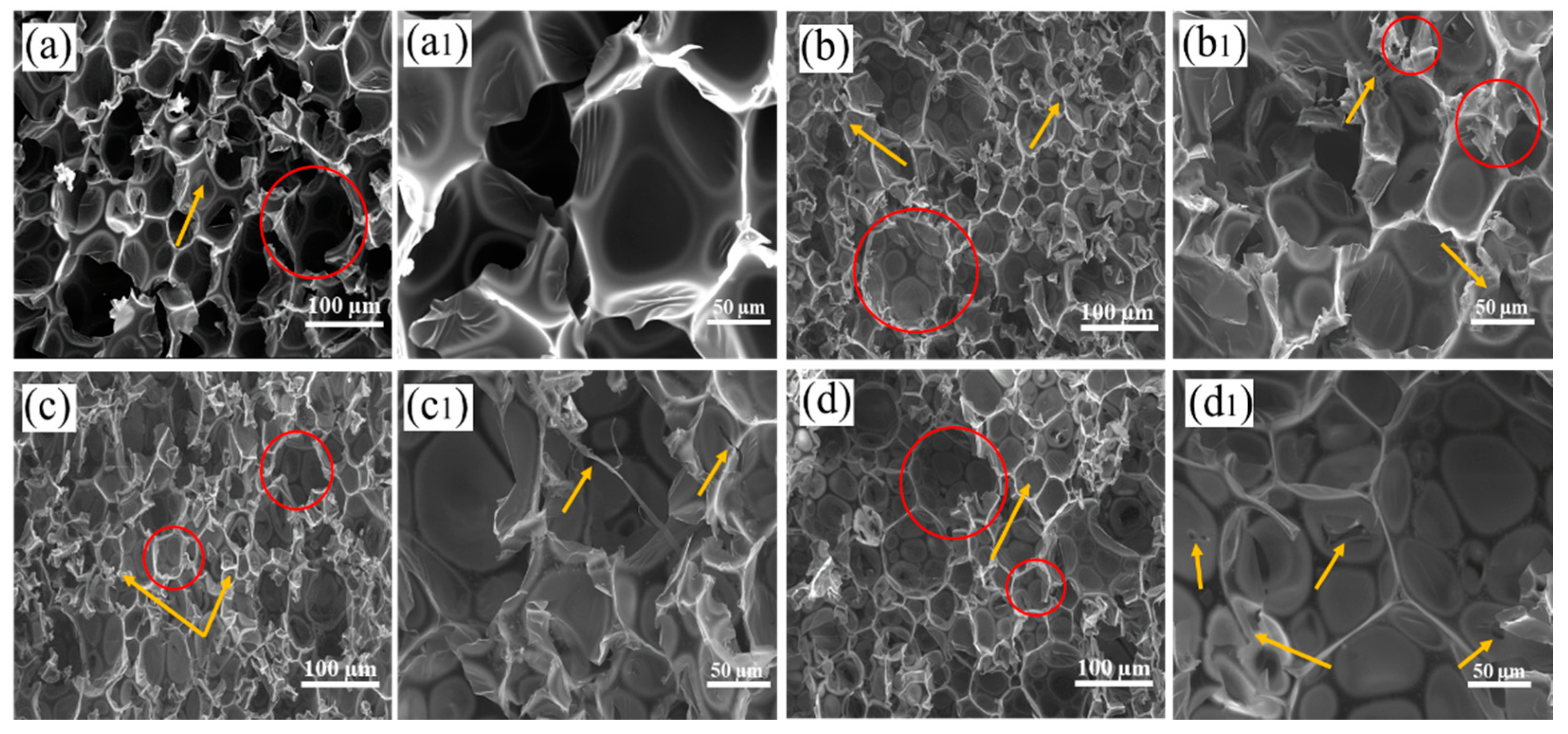


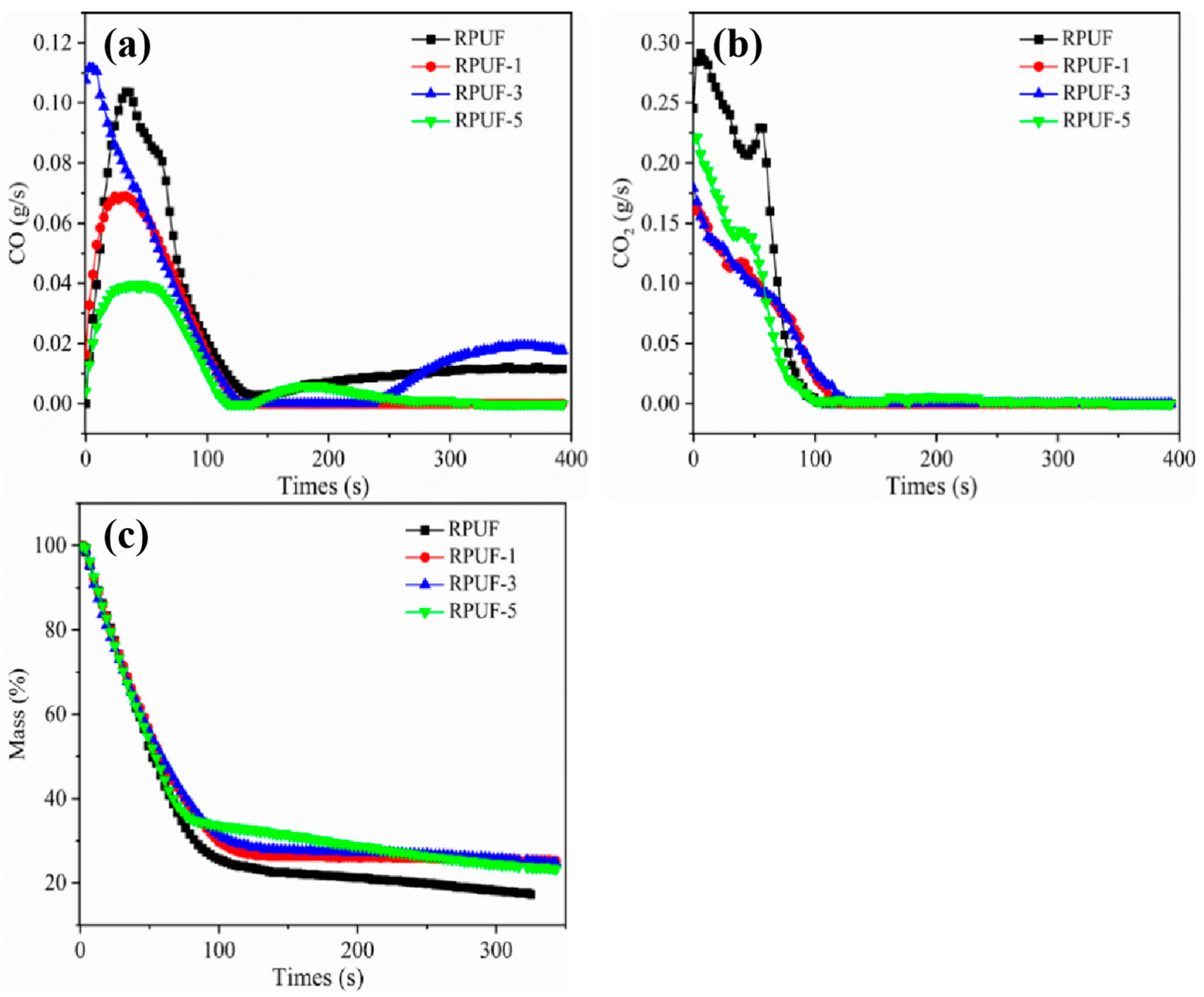
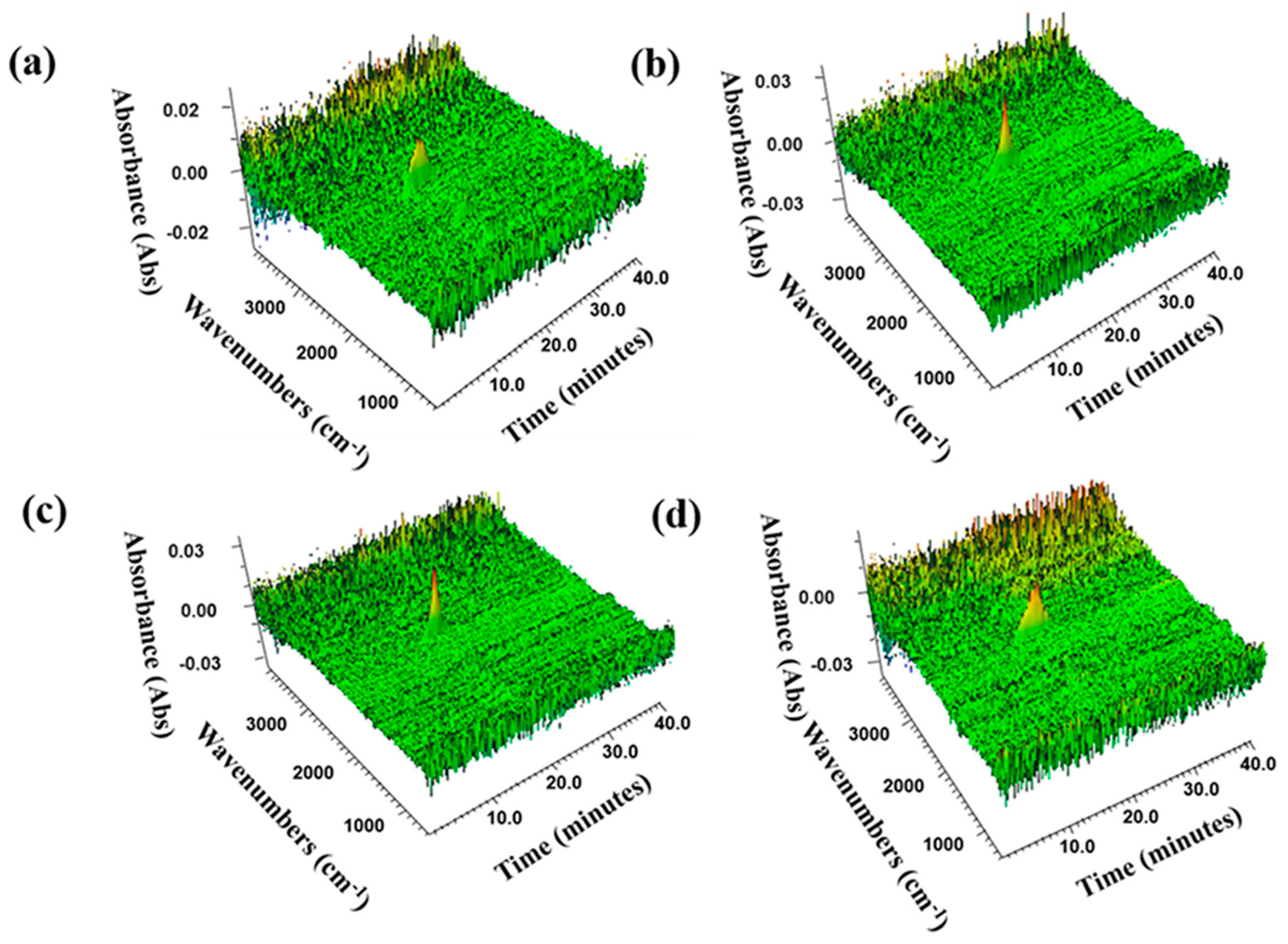
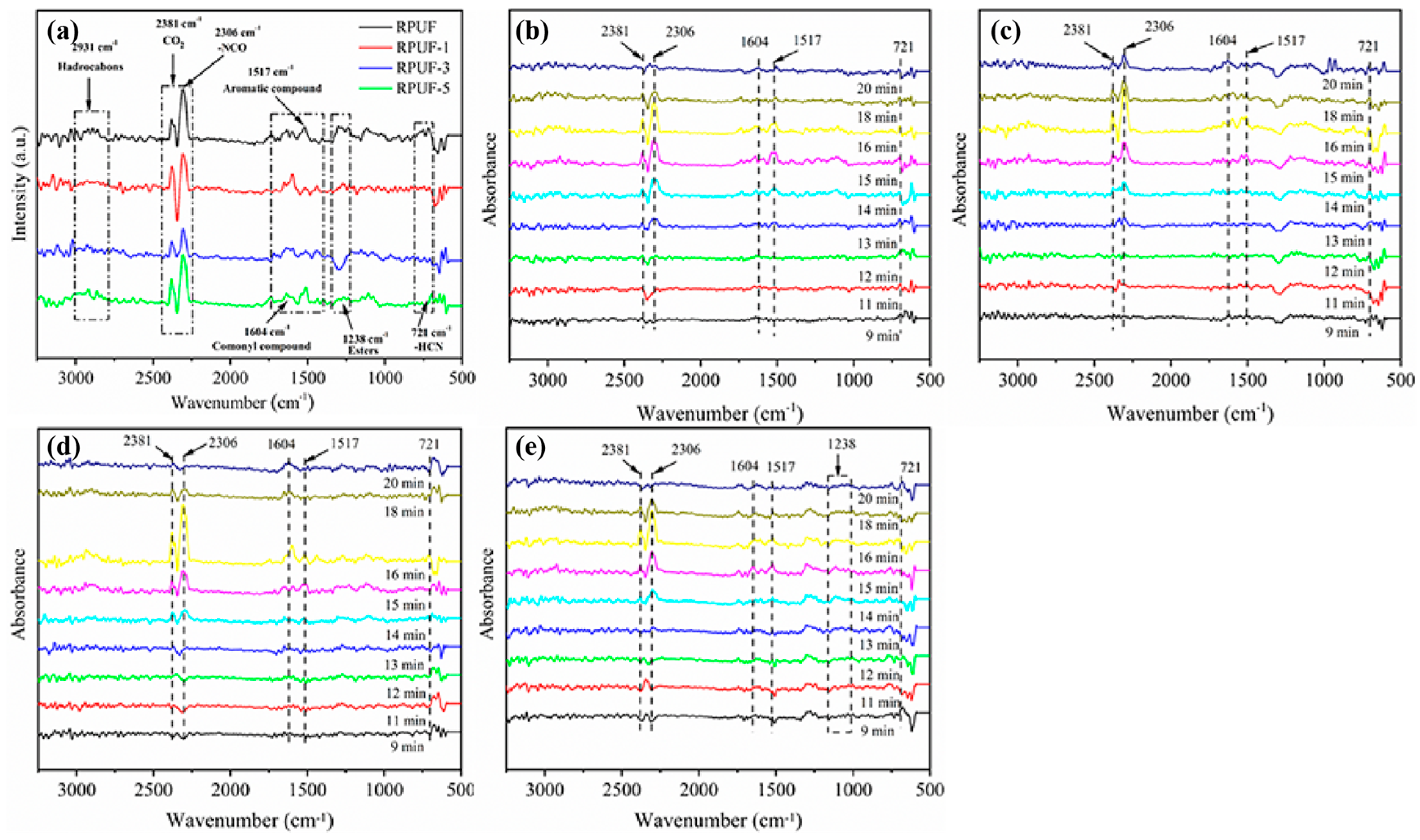
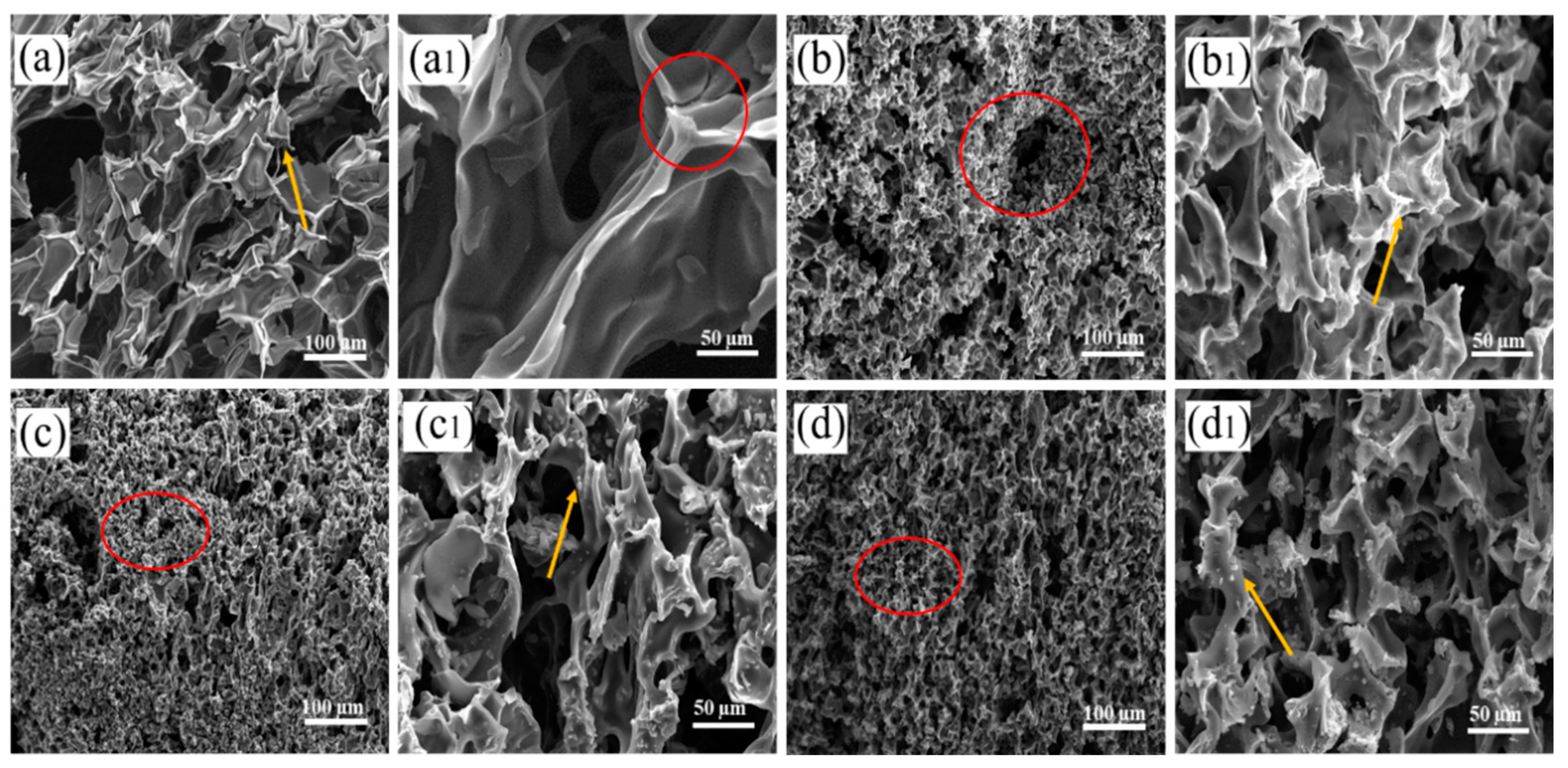

| Sample | Thermal Conductivity/(W/m·k) | Compressive Strength/(MPa) | Apparent Density/(kg/m3) |
|---|---|---|---|
| RPUF | 0.0373 | 0.325 | 45.28 |
| RPUF-1 | 0.0392 | 0.315 | 71.84 |
| RPUF-2 | 0.0380 | 0.289 | 63.80 |
| RPUF-3 | 0.0389 | 0.273 | 61.44 |
| RPUF-4 | 0.0381 | 0.257 | 61.20 |
| RPUF-5 | 0.0369 | 0.240 | 59.25 |
| Sample | LOI/vol% | UL-94. 3.2 mm Bar | ||
|---|---|---|---|---|
| t1/t2a (s) | Dripping | Rating | ||
| RPUF | 19.0 | BCb | Y | NRc |
| RPUF-1 | 24.8 | 4.37/0 | N | V-0 |
| RPUF-2 | 23.7 | 6.42/0 | N | V-0 |
| RPUF-3 | 23.4 | 6.84/0 | N | V-0 |
| RPUF-4 | 22.4 | 8.72/0 | N | V-0 |
| RPUF-5 | 20.4 | BC | N | NR |
| Sample | T−5wt%/°C | Tmax1/°C | Tmax2/°C | 700 °C Carbon Residue/wt% |
|---|---|---|---|---|
| RPUF | 271 | 330 | 460 | 14.0 |
| RPUF-1 | 283 | 328 | 490 | 24.4 |
| RPUF-3 | 277 | 333 | 470 | 28.8 |
| RPUF-5 | 272 | 350 | 463 | 29.3 |
| Sample | RPUF | RPUF-1 | RPUF-3 | RPUF-5 |
|---|---|---|---|---|
| TTI (s) | 5 | 3 | 4 | 3 |
| Tp (s) | 72 | 68 | 72 | 64 |
| Td (s) | 390 | 415 | 516 | 441 |
| pHRR (kW/m2) | 296.5 | 145.1 | 134.9 | 188.6 |
| THR (MJ/m2) | 28.18 | 18.95 | 16.16 | 21.52 |
| FPI (m2·s/kW) | 0.0169 | 0.0207 | 0.0297 | 0.0159 |
| FGI (kW/m2·s) | 4.12 | 2.13 | 1.87 | 2.95 |
| CY (wt%) | 17.27 | 25.22 | 24.77 | 23.29 |
| Sample | LY-4110 /g | PM-200 /g | LC /g | AK-8805 /g | A33 /g | TEOA /g | Water /g | SS /g | DMPY /g |
|---|---|---|---|---|---|---|---|---|---|
| RPUF | 100 | 135 | 0.5 | 2 | 1 | 3 | 2 | 0 | 0 |
| RPUF-1 | 100 | 135 | 0.5 | 2 | 1 | 3 | 2 | 60.9 | 0 |
| RPUF-2 | 100 | 135 | 0.5 | 2 | 1 | 3 | 2 | 40.6 | 20.3 |
| RPUF-3 | 100 | 135 | 0.5 | 2 | 1 | 3 | 2 | 30.45 | 30.45 |
| RPUF-4 | 100 | 135 | 0.5 | 2 | 1 | 3 | 2 | 20.3 | 40.6 |
| RPUF-5 | 100 | 135 | 0.5 | 2 | 1 | 3 | 2 | 0 | 60.9 |
Publisher’s Note: MDPI stays neutral with regard to jurisdictional claims in published maps and institutional affiliations. |
© 2022 by the authors. Licensee MDPI, Basel, Switzerland. This article is an open access article distributed under the terms and conditions of the Creative Commons Attribution (CC BY) license (https://creativecommons.org/licenses/by/4.0/).
Share and Cite
Zhu, M.; Yang, S.; Liu, Z.; Pan, S.; Liu, X. Flame-Retarded Rigid Polyurethane Foam Composites with the Incorporation of Steel Slag/Dimelamine Pyrophosphate System: A New Strategy for Utilizing Metallurgical Solid Waste. Molecules 2022, 27, 8892. https://doi.org/10.3390/molecules27248892
Zhu M, Yang S, Liu Z, Pan S, Liu X. Flame-Retarded Rigid Polyurethane Foam Composites with the Incorporation of Steel Slag/Dimelamine Pyrophosphate System: A New Strategy for Utilizing Metallurgical Solid Waste. Molecules. 2022; 27(24):8892. https://doi.org/10.3390/molecules27248892
Chicago/Turabian StyleZhu, Mingxin, Sujie Yang, Zhiying Liu, Shunlong Pan, and Xiuyu Liu. 2022. "Flame-Retarded Rigid Polyurethane Foam Composites with the Incorporation of Steel Slag/Dimelamine Pyrophosphate System: A New Strategy for Utilizing Metallurgical Solid Waste" Molecules 27, no. 24: 8892. https://doi.org/10.3390/molecules27248892
APA StyleZhu, M., Yang, S., Liu, Z., Pan, S., & Liu, X. (2022). Flame-Retarded Rigid Polyurethane Foam Composites with the Incorporation of Steel Slag/Dimelamine Pyrophosphate System: A New Strategy for Utilizing Metallurgical Solid Waste. Molecules, 27(24), 8892. https://doi.org/10.3390/molecules27248892





